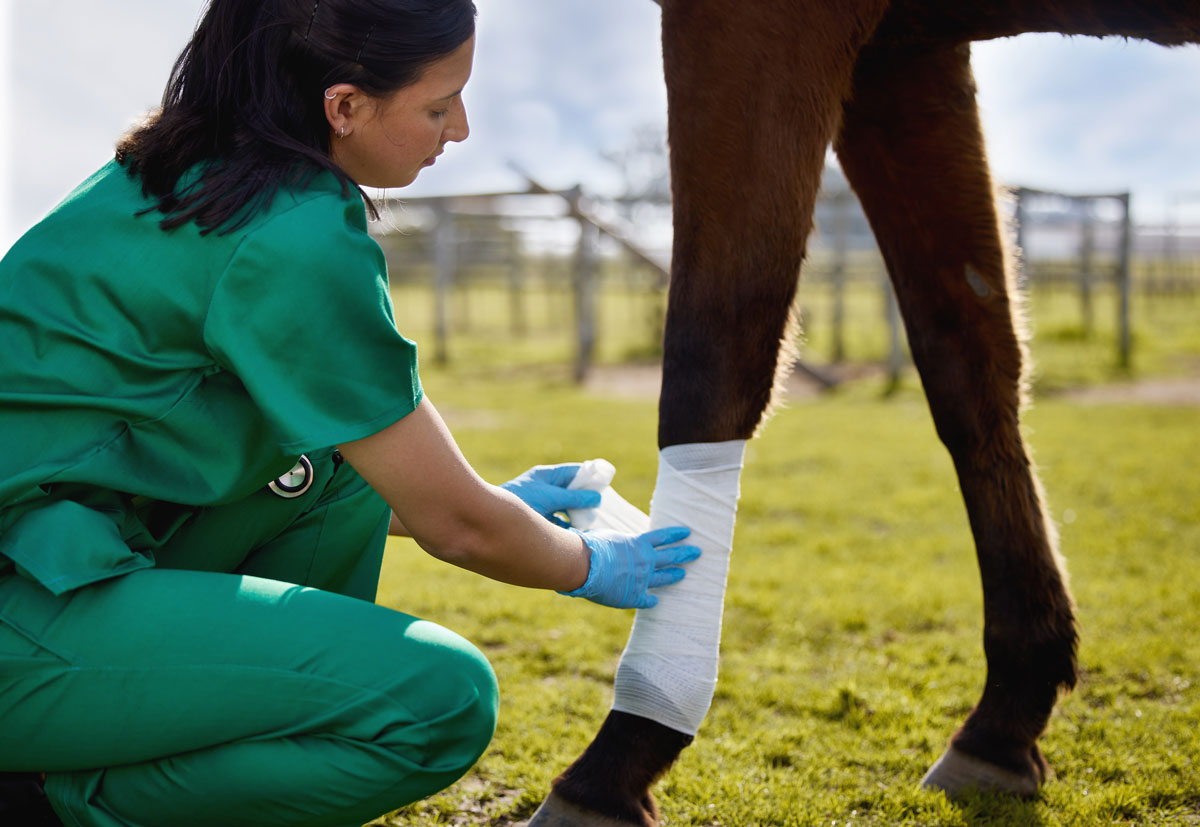
At the 2021 AAEP Convention in Nashville, Tennessee, Dean Hendrickson, DVM, MS, DACVS, of Colorado State University, discussed a variety of advanced wound dressings that can help foster a healing environment for equine wounds. These are best used after debridement and in cases where there is insufficient skin to accomplish a primary or delayed primary wound closure. Primary closure is not always an option due to significant wound contamination or a wound that is so large that it requires skin grafting.
Placing an occlusive (non-porous) dressing over a wound nearly doubles the rate of re-epithelialization compared to leaving a wound exposed to the air. Such a dressing facilitates wound closure in 12-15 days as opposed to 25-30 days if left uncovered. Hendrickson stresses that wounds exposed to the air experience increased inflammation, pain, itchiness, thicker crusts and are likely to result in more scarring. In contrast, a dressing maintains moisture in the wound bed while specific advanced dressings help with mechanical debridement. An occlusive dressing also provides constant thermal regulation important to epithelialization.
A wound that is expressing a lot of exudate does best initially with a non-occlusive dressing that allows exudate to pass through. A wound thrives best with some moisture, but too much leads to tissue maceration. There might be a need to amplify tissue debridement early on, and this can be accomplished with hypertonic saline (200 grams of salt to 1 liter of saline) or a Curasalt compress. Such compounds work by osmotic action and are applied to infected or heavily exudative wounds only. Honey also has some debridement action and is antibacterial. Antimicrobial dressings (A.M.D. or Kerlix) are able to damage bacterial cells while not adversely impacting host cells.
Moisturizing Dressings
Hydrogels (Curagel)—composed of water, glycerin and polymer—are used for dry wounds or burns as these dressings hold water and also hold well to tissues. The gel can be applied directly even to cavernous wounds or massaged into gauze. These dressings are totally occlusive and can be left in place for five days.
Granulation and Wound Contraction Dressings
Hendrickson really likes calcium alginate (a derivative of seaweed) dressings to stimulate formation of healthy granulation tissue. This material interacts with sodium in the wound to encourage myofibroblast proliferation and wound contraction. It absorbs up to 200 times its weight in exudate, so it is useful for moderate to heavily draining wounds. Alginate also creates a moderate inflammatory response, which is often lacking in initial phases of wound healing. Such an early inflammatory response produces healthy granulation tissue unlike what is seen with “proud flesh” development that is typically infected with bacteria or irritated by inappropriate topical medications that increase necrosis.
Another great application of calcium alginate dressing is for a bone sequestrum as this dressing helps to re-establish the periosteum or soft tissue coverage of bone, particularly following debridement of superficial devitalized bone. The dressing should be pre-moistened with saline before applying to bone. Hendrickson recommends leaving it for three days rather than changing every day.
In most circumstances, calcium alginate dressings are left in place for 5-7 days (at least 3 days), but if left on too long, they can delay wound healing and epithelialization. At bandage change, it might be appropriate to move on to a different dressing type depending on progress of the wound.
Epithelialization Dressings
Encouragement of epithelialization is accomplished using semi-occlusive foam dressings (Hydrasorb or COPA hydrophilic foam). Epithelial cells prefer a moist, not soupy, environment to migrate across a wound bed. They also do best in an even thermal environment. Proud flesh can be minimized by changing the surface temperature of a wound by 1-2 degrees Fahrenheit. Epithelial cells proliferate and fibroblasts calm down due to a slight thermal increase, with resultant migration of epithelial cells. A semi-occlusive foam dressing can be left in place without frequent bandage changes that would increase risk of infection by opening the wound to the environment. Frequency of bandage change is based on the amount and character of exudate and can typically be left on for 5-7 days.
Silicone dressings, while expensive, have a helpful role in dealing with heel bulb injuries. They stop recurrent exuberant granulation tissue by occluding microvessels. Hendrickson suggests debriding the wound via surgical excision, applying vitamin E, then using the silicone dressing, which is left in place for 5-6 days. The horse’s pain is lessened as is scarring.








